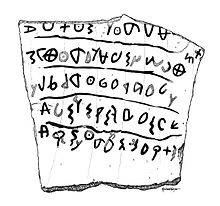| Khirbet Qeiyafa ostracon | |
|---|---|
 | |
| Material | Clay |
| Created | c. 1000 BC |
| Discovered | 2008 Beit Shemesh, Jerusalem, Israel |

The Khirbet Qeiyafa ostracon is a 15-by-16.5-centimetre (5.9 in × 6.5 in) ostracon (a trapezoid-shaped potsherd) with five lines of text,[1] discovered in Building II, Room B, in Area B of the excavations at Khirbet Qeiyafa in 2008.[2] Hebrew University archaeologist Amihai Mazar said the inscription was the longest Proto-Canaanite text ever found.[3] Carbon-14 dating of 4 olive pips found in the same context with the ostracon and pottery analysis offer a date of Iron Age IIA c. 3,000 years ago (late 11th/early 10th century BCE).[4]
In 2010, the ostracon was placed on display in the Iron Age gallery of the Israel Museum in Jerusalem.[5]
- ^ "Most ancient Hebrew biblical inscription deciphered". University of Haifa. January 10, 2010. Archived from the original on October 5, 2011. Retrieved November 5, 2011.
- ^ Misgav, Haggai; Garfinkel, Yosef; Ganor, Saar (2009). "The Ostracon". In Garfinkel, Yosef; Ganor, Saar (eds.). Khirbet Qeiyafa, Vol. 1: Excavation Report 2007–2008. Jerusalem. pp. 243–257. ISBN 978-965-221-077-7.
{{cite book}}: CS1 maint: location missing publisher (link) - ^ "'Oldest Hebrew script' is found". BBC News. October 30, 2008. Retrieved November 5, 2011.
- ^ Earliest known Hebrew text unearthed at 3,000 year old Judean fortress, Israel Ministry of Foreign Affairs, 30 Oct 2008. Accessed 18 February 2022.
- ^ Cite error: The named reference
ostracon2was invoked but never defined (see the help page).
© MMXXIII Rich X Search. We shall prevail. All rights reserved. Rich X Search
